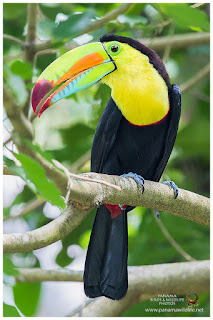During the month of November we went a couple of times to Cerro Ancón (Ancon Hill) the iconic hill located north to the Old Quarter of Panama City. This hill besides having a huge Panamanian flag is the quintessential hawk-watching point during fall migration of birds of prey.
Of course, Panama not only has a role as a transitory bridge for birds of prey but also host a variety of migratory birds like warblers, vireos, cardinals, tyrant-flycatchers, cuckoos, and wading and coastal birds. Panama is used by hundreds of thousands of birds native to North America that travel to South America during the Northern Hemisphere winter but also host temporarily several of the migratory species as winter residents. The following post compiles the photographic results of these visits.
Resident species
Disregarding we were expecting to photograph migratory birds of prey, we also had opportunities to shoot some resident species.
Keel-billed Toucan (Ramphastos sulfuratus) can be found from Southern Mexico to Venezuela and Colombia. It roosts in the
canopies of tropical, subtropical, and lowland rainforests, up to altitudes of 1,900 m (6,200 ft). The diet of keel-billed toucans consists mostly of a wide range of fruit, but may also include insects, eggs, nestlings and lizards, as well as small birds.In Panama this species is
common on both slopes but more local on Pacific.

Geoffroy's Tamarin (Saguinus geoffroyi), also known locally as
"Mono Tití" is a small monkey, found in Panama and Colombia. It is predominantly
black and white,
with a reddish nape. It spends most of its time in trees, but does come down to the ground occasionally. It lives in groups that most often number between three and five individuals. It eats a variety of foods, including insects,
exudates, fruits and other plant parts. But since its teeth are not adapted for gouging trees to get to the sap, it can only eat exudates when they are easily available. It lives in various types of forest, including
primary and
secondary forest, and dry and moist tropical forest. In Panama, it prefers
secondary forests with moderate humidity. It occurs in
central and eastern
Panama, with the range extending slightly west of the Panama Canal zone. It is less common on the Atlantic coast of Panama than the Pacific coast, and is only abundant on the Atlantic coast in areas near the Canal zone that have been modified by man.


Resident Tropical Kingbird (Tyrannus melancholicus) hanging around with the migratory Eastern Kingbird (Tyrannus tyrannus)
Palm Tanager (Thraupis palmarum)
Zone-tailed Hawks (Buteo albonotatus)
Migratory species
Eastern Kingbird (Tyrannus tyrannus) is a large tyrant flycatcher native to North America. Their breeding habitat is open areas across North America. These birds aggressively defend their territory, even against much larger birds, similar to Tropical Kingbird. These birds migrate in flocks to South America. In Panama it's a common transient and found in open areas and in forest edge and woodland edge. Often occurring in large flocks.



Swainson's Hawk (Buteo swainsoni), colloquially known as the grasshopper hawk or locust hawk and in Argentina as
gavilán langostero or
aguilucho langostero, as it is very fond of (locusts and grasshoppers) and will voraciously eat these insects whenever they are available. Their breeding habitat is
prairie and dry grasslands in western North America. This species is a long-distance migrant, wintering in Argentina; it has been recorded as a vagrant in neighboring Chile, in the island countries of the Dominican Republic, and Trinidad and Tobago, and in Norway. In Panama it's an
abundant transient soaring in huge flocks, often with Turkey Vultures and Broad-winged Hawks. It's a
rare winter resident, and we have been able to see them in
open areas in Pacific lowlands, recently.
Broad-winged Hawk (Buteo platypterus)
Migrant Turkey Vulture (Cathartes aura). We also have a resident race and winter residents.
The genus Contopus is a group in the Tyrant flycatcher family. These birds are commonly known as pewees, from the call of one of the more common members of this vocal group. They are generally charcoal-grey birds with wing bars that live in wooded areas. The eastern wood pewee (C. virens) and the western wood pewee (C. sordidulus) were formerly considered to be a single species. The two species are virtually identical in appearance, and can be distinguished most easily by their calls.
The Great Crested Flycatcher (Myiarchus crinitus) is a common winter resident, occurring throughout the country in middle and upper levels of forest.























Comments
Post a Comment